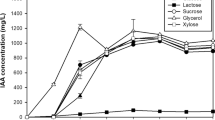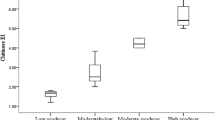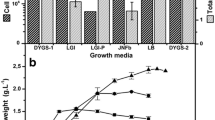Abstract
The development of biofriendly and economical alternatives to chemical pesticides is a globally important scientific challenge. In this work, Karanja-based media conditions were optimized for obtaining high production of biomass and spores of a biocontrol agent, the entomopathogenic fungus Paecilomyces lilacinus 6029, using a two-step statistical approach coupled with rigorous experimentation. In the first step, non-edible Karanja cake was screened out as a major substrate from other oil cakes. In the second step, biomass production was maximized by applying response surface methodology to experimental variations in key physico-chemical factors: carbon/nitrogen (C/N) ratio and pH. This approach eventually predicted a maximum biomass production of 10.559 g/l with a medium having a C/N ratio of 35.88 and pH 5.9. An experimental production of 10.529 g/l biomass was obtained. The remarkable agreement between the predicted and the experimentally obtained biomass confirm the validity of the approach utilized to maximize production of P. lilacinus.





Similar content being viewed by others
References
Adane K, Moore D, Archer SA (1996) Preliminary studies on the use of Beauueria bassiana to control Sitophilus zeamais (Coleoptera: Curculionidae) in the laboratory. J Stored Prod Res 32:105–113
Chen MJ, Chen KN, Lin CW (2005) Optimization on response surface models for the optimal manufacturing conditions of dairy tofu. J Food Eng 68:471–480
Fiedler Z, Sosnowska D (2007) Nematophagous fungus Paecilomyces lilacinus (Thom) Samson is also a biological agent for control of greenhouse insects and mite pests. Biocontrol 52:547–558
Fransson PMA, Anderson IC, Alexander IJ (2007) Ectomycorrhizal fungi in culture respond differently to increased carbon availability. FEMS Microbiol Ecol 61:246–257
Gao L, Sun MH, Liu XZ, Che YS (2007) Effects of carbon concentration and carbon to nitrogen ratio on the growth and sporulation of several biocontrol fungi. Mycol Res 111:87–92
Jackson MA, McGuire MR, Lacey LA, Wraight SP (1997) Liquid culture production of desiccation tolerant blastospores of the bioinsecticidal fungus Paecilomyces fumosoroseus. Mycol Res 101:35–41
Khan A, Williams KL, Nevalainen HKM (2004) Effects of Paecilomyces lilacinus protease and chitinase on the eggshell structures and hatching of Meloidogyne javanica juveniles. Biol Control 31:346–352
Park YS, Kang SW, Lee JS, Hong SI, Kim SW (2002) Xylanase production in solid state fermentation by Aspergillus niger mutant using statistical experimental designs. Appl Microbiol Biotechnol 58:761–766
Park JO, Hargreaves JR, McConville EJ, Stirling GR, Ghisalberti EL (2004) Production of leucinostatins and nematicidal activity of Australian isolates of Paecilomyces lilacinus (Thom) Samson. Lett Appl Micobiol 38:271–276
Prabhu TM, Devakumar C, Sastry VRB, Agrawal DK (2002) Quantification of Karanjin using high performance liquid chromatography in raw and detoxified Karanj (Pongamia glabra vent) seed cake. Asian-Aust J Anim Sci 15:416–420
Prasanna R, Lata TR, Gupta V, Chaudhary V, Middha S, Joshi M, Ancha R, Kaushik BD (2008) Evaluation of fungicidal activity of extracellular filtrates of cyanobacteria-possible role of hydrolytic enzymes. J Basic Microbiol 48:186–194
Ramachandran S, Singh SK, Larroche C, Soccol CR, Pandey A (2007) Oil cakes and their biotechnological applications – A review. Bioresource Technol 98:2000–2009
Scott PT, Pregelj L, Chen N, Hadler JS, Djordjevic MA, Gresshoff PM (2008) Pongamia pinnata: an untapped resource for the biofuels industry of the future. Bioenerg Res 1:2–11
Sharma S, Verma M, Sharma A (2012) Utilization of non edible oil seed cakes as substrate for growth of Paecilomyces lilacinus and as biopesticide against termites. Waste Biomass Valor. doi:10.1007/s12649-012-9134-6
Shokuhfar A, Khalili SMR, Ashenai Ghasemi F, Malekzadeh K, Raissi S (2008) Analysis and optimization of smart hybrid composite plates subjected to low-velocity impact using the response surface methodology (RSM). Thin Wall Struct 46:1204–1212
Singh B, Satyanarayana T (2006) A marked enhancement in phytase production by a thermophilic mould Sporotrichum thermophile using statistical designs in a cost-effective cane molasses medium. J Appl Microbiol 101:344–352
Sivaramakrishnan S, Gangadharan D (2009) Edible oil cakes. In: Singh nee’ Nigam P, Pandey A (eds) Biotechnology for agro-industrial residues utilization. Springer, New York, pp 253–271
Vega FE, Jackson MA, Mercadier G, Poprawski TP (2003) The impact of nutrition on spore yields for various fungal entomopathogens in liquid culture. World J Microbiol Biotechnol 19:363–368
Xiao ZJ, Liu PH, Qin JY, Xu P (2007) Statistical optimization of medium components for enhanced acetoin production from molasses and soybean meal hydrolysate. Appl Microbiol Biotechnol 74:61–68
Acknowledgment
The authors gratefully acknowledge financial support provided by the National Oilseed and Vegetable Oil Development (NOVOD) Board, Gurgaon, India, for carrying out the research.
Author information
Authors and Affiliations
Corresponding author
Rights and permissions
About this article
Cite this article
Sharma, A., Sharma, S., Mittal, A. et al. Statistical optimization of growth media for Paecilomyces lilacinus 6029 using non-edible oil cakes. Ann Microbiol 64, 515–520 (2014). https://doi.org/10.1007/s13213-013-0683-0
Received:
Accepted:
Published:
Issue Date:
DOI: https://doi.org/10.1007/s13213-013-0683-0




